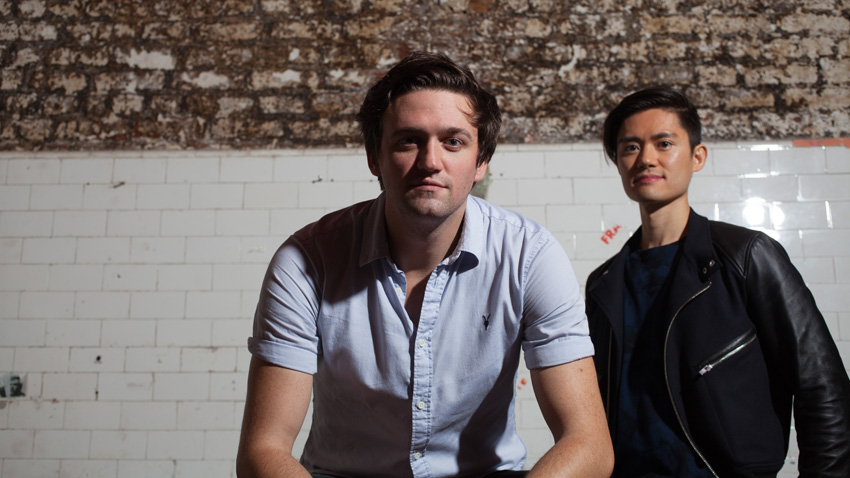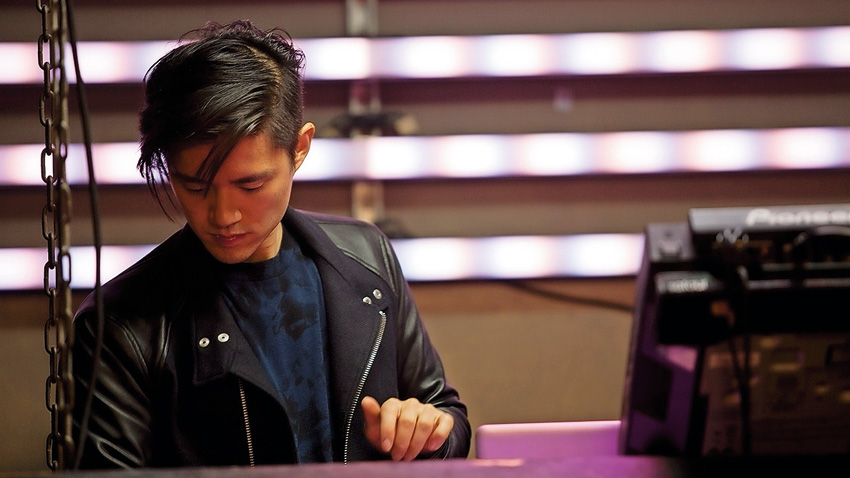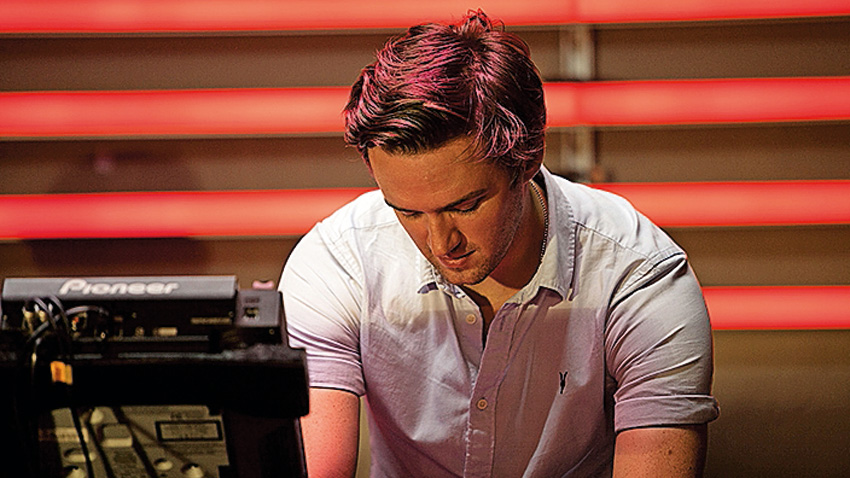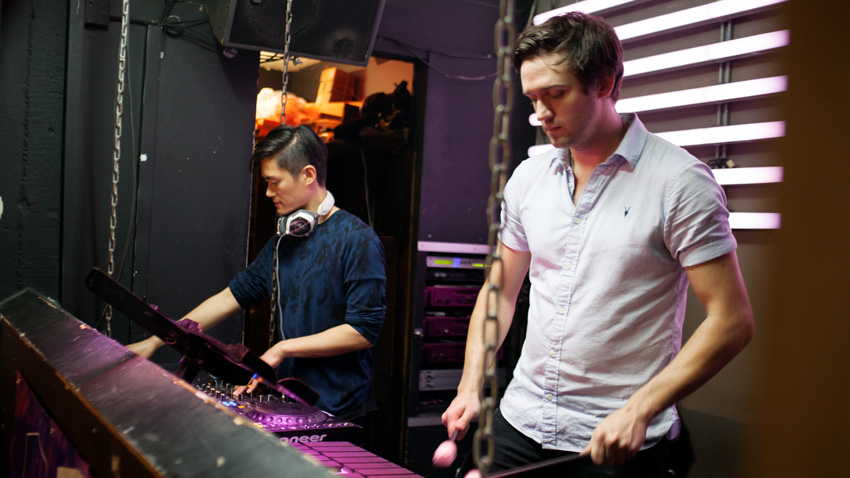Autograf on bringing art and electronic music together
Combining electronic music and art, tropical house sensations Autograf hope to change EDM's obsession with drugs and drops.

Art and music have always been comfortable bedfellows, but in today's world of digital downloads the visual element is often downgraded to a JPEG. Enter Autograf, the unlikely combination of two art students and a subcontractor for the US Department of Defense.
As a trio, the collective released bootleg remixes of Stevie Wonder, Odesza and Pharrell, chalking up eight No 1 releases on Hype Machine. The industry couldn't help but notice, and commissions swiftly followed for Fatboy Slim and Avicii makeovers. Meanwhile, Autograf's second single, Metaphysical, goes back to the band's audio-visual roots, amalgamating pop art with their emotive take on House.
When did you first start to dabble in music production?
Jake: "My parents made me take piano lessons from a fairly early age before switching over to drums. I played in classical marching bands and also a jazz band at school. In high school, I was in rock bands, but as soon as I went to college I quit music and got a job. Then one day I was at an Apple store getting an iPhone and saw a box of Logic close to the checkout and kind of bought it on a whim - on that same trip to the mall, I was walking past a Barnes & Noble and got a copy of Future Music. Now I've got a wish list because I've been reading Future Music for so long."
You must have known something about production to even know what Logic, or Future Music, were…
Jake: "Yeah, I'd dabbled with FruityLoops in high school but it never stuck; I just didn't like the way it was laid out. But when I was in college I'd got used to using Macs, and that's what helped pull the trigger for me, because Logic was a solid Mac product. I wanted to get back into music really badly, and so from that point on Logic became my… I wouldn't call it a hobby, but something I did immediately when I got home from work instead of watching TV. It's what I did to relax."
Louis: "When I was in middle school I played violin, and in high school guitar. Like Jake, after college I quit all music and it wasn't until the whole music scene with Justice, Digitalism and the Kitsuné Compilations came about that I got interested in DJing and bought some of my first vinyl. That sparked my initial interest in electronic music and getting to DJ on stage. I was really into the electroclash movement - bands like Tiga and Felix da Housecat - and before that, Global Underground and new wave stuff like Joy Division, New Order and Prince… a lot of music from the 80s."
Get the MusicRadar Newsletter
Want all the hottest music and gear news, reviews, deals, features and more, direct to your inbox? Sign up here.
Jake: "For me, it was Danger - the French electro act - and immediately before that, Chemical Brothers and Crystal Method, but then I was also listening to Justice, and house acts like Deadmau5 were starting to get big at that point. I'd also been a huge fan of Sasha & Digweed and Basement Jaxx."
How did you come to form as a trio?
Louis: "I started DJing and met the third part of our group, Mikul Wing. We started doing underground events in Chicago; illegal loft parties where the cops would come in and bust us for health code violations. That was pretty big in Chicago at the time, before everything became corporate. Then we found Jake, who was putting music out on SoundCloud but had never played anywhere, and decided to book him because we liked his music. What we didn't realise is that he'd built an eight-foot robot and actually brought it out to us to go DJing with. We soon realised he was multitalented and decided to start a project there and then - our own thing collaborating with music and large-scale stage props and installations, because Jake has this background in welding and metalwork."
Jake: "I was working as a machinist, welder and fabricator during the day. I was studying sculpture for my senior thesis at art school and I made this eight-foot-tall robotic statue out of cast aluminium, where the whole body could move around with these pneumatic pistons inside of him. Building that robot was how I got the welding job as a subcontractor for the Department of Defense - so I was doing a bunch of exotic metal stuff and a whole bunch of other stuff I can't talk about [laughs]."
"Building that robot was how I got the welding job as a subcontractor for the Department of Defense - so I was doing a bunch of exotic metal stuff and a whole bunch of other stuff I can't talk about."
You got into the industry by remixing other artists' records and uploading them online…
Louis: "In the beginning, it was really hard to get people to notice us, so our idea was to do bootlegs. The first track we put out was a remix of Magic Stick by 50 Cent and Lil Kim. I just heard the song come on in the car and thought it would be cool as a deep house remix. We didn't even know what our sound was going to be at the time.
"So we put that track out and got some traction. Our first three remixes were put out on SoundCloud; then one of our early Marvin Gaye remixes went on Hype Machine and shot to No 1. From then on it started getting easier in terms of people listening and getting bloggers to say hello back to us. Eventually, we started getting commissioned remixes and did bigger acts like Odesza, Fatboy Slim, Faithless… Avicii [laughs].
"There were lots of versions of every song we put out, so we'd always take some of those throwaways and keep them in our back pocket to modify or eventually release later down the road."
Your tracks are accompanied by pop art. In what format is that presented to the listener and what's the idea behind it?
Jake: "The whole project was originally about art. We threw this art party at the House of Blues in Chicago - an Andy Warhol theme, which we presented as a boiler room-type thing. The entire stage was filled with art that we'd made - big installations - and we DJ'd on the floor. After that, the music took over and we haven't been doing nearly as much art - but now we're starting to get back into it with our latest releases by making an art piece to go with them.
"We're also designing and building our own instruments for our next couple of shows. I've worked on controllers for The Crystal Method and made a different bunch of MIDI controllers, doing all of the coding and LED soldering."
Louis: "We were really getting away from the art, so from here on out we're going to create an original physical art piece that's either inspired by the music or where the music is inspired by the art.
"Right now, we have two pieces that have been unveiled. They're just mixed media physical pieces, and we'll take a photo to serve as the digital art piece but, once a body of work is completed, the plan is to take all the physical pieces, put them up in a gallery and perhaps auction them. At one point, we made wood cut-outs of animals, painted them with blackboard paint and went to this so-called EDM festival and plastered them all around. We just felt the whole electronic culture has got too far away from art and become more about the drugs and the heavy drops, which if you go to watch seems a bit mindless. So we put these animals around Chicago in an urban setting to make people question their natural surroundings and reality, but with the giraffe piece the neck got ripped off. I guess that's a reflection of society right now [laughs]."

What's your approach to making music?
Jake: "The bulk of the production is done by me in my studio in Kentucky. We have a very DIY ethic, so I spent 13 months building my own studio from the ground up in my back yard. I excavated and dug the foundations, cinder block walls - the whole thing.
"So I have my little bunker down there and Mikul and Louis live up in Chicago. What I've noticed is that I'm good at making a whole bunch of material, but don't really know what sounds good and don't have a DJ background - I just appreciate electronic music. So I'll send maybe a dozen things to Mikul and Louis and they have what I call the 'golden ears'. So they'll go through, saying, 'This is great, this is shit, that's cool, this is shit'. I'm good at churning out a whole bunch of puzzle pieces, but they make the finished puzzle."
Do you record everything in the box?
Jake: "No, not all of it. I've got a couple of pieces of outboard gear. I've got a Sherman Filterbank, which I love running things through, and an external summing mixer. A lot of times I'll run my busses through that so I can sum everything in analogue before turning it back in. The Sherman has a real spring reverb in it, so sometimes I'll throw that on. Otherwise, it's pretty much all in the box. I've actually got a really big Soundcraft Ghost 24-channel, eight buss summing mixer console, but still haven't bought the power supply."
So presumably you believe that outboard adds something critical to whatever you produce in the box.
Jake: "When we do our mastering, we rent out a studio space and use their outboard, because there are still some things that you just can't accomplish digitally. Because our touring schedule has been so heavy lately, we pretty much have to keep the majority of the production digital in order to keep up with the output. I was given that console, which was made in 2001, but I know a guy in Nashville who can supercharge it by taking out every single channel - all the capacitors, put new ones in and change all the contacts to gold. Basically, he could take that Soundcraft, which is pretty good to begin with, and lower the noise floor and other sonics to pretty much the same capabilities as a Neve desk, for a fraction of the price."
What approach do you take to analogue summing?
Jake: "I started experimenting with it because the idea of summing makes sense to me, as it's very hard to accomplish digitally. Depending on what your gain staging is like, summing can give you a different sort of sound than you would get using hardware compression. Digital is good - you can sum pretty well up to 16 channels - but in our sessions, if you've got 64 tracks you're going to get a lot of diminished headroom. If you think of it as Tetris, there's going to be little holes in there that diminish your headroom; but in the analogue domain, everything smashes in perfectly, so it's always made sense in my mind that analogue summing is something that you absolutely cannot accomplish digitally. Maybe in ten years they'll be able to figure it out, but that's just something I wanted to do. You'll notice our mixes are still pretty loud, and we're still working on that to get them even louder, but, while we like to push the limits, we still want to maintain a solid dynamic range."
Do you find that the 'compression war' we often witness is to the detriment of the quality of the music?
Jake: "Oh yeah, but you can still have a high dynamic range in your songs based on the writing. A lot of people are always talking about eliminating compression, but if you write your songs using different techniques, you can still maintain the illusion of that dynamic range without compromising on audio quality so much. I learned this from my days doing percussion; it's not so much about the notes you do play, it's the notes you don't play. You want to create holes in your songs and those holes leave a gap. Sometimes what I'll do in the DAW is… say you've got 16 bars, I'll fill them with a hi-hat, then, by using a subtractive method, I'll start taking hats out; and I'll do the same thing with toms.
"It's just a different way of thinking for making loops or rhythms, where you think in a subtractive way. I learned that from sculpture; you've got a block of wood - it's not going to get any bigger, and you've got to chip at it the entire time. If you keep on chipping, you can make the entire thing more dynamic - you're making it deeper, going deeper into the piece, and you can also add more depth to a song by taking things away."
Because Louis and Mikul don't use Logic is it easy for you to adapt the tracks based on their suggestions?
Jake: "Yeah, it's way better. Louis and Mikul don't speak to me in terms of producer jargon, which I think is the best way to do it. One thing I've noticed is that when you send tracks to another producer they give you very specific feedback. Instead of listening to the composition as a whole, something will stick out and annoy them, because they know it's a mistake. But it's a mixing error, not necessarily a vibe or something wrong with the track. They'll say, 'You need to put a 3dB scoop around 200Hz on that bass', whereas Louis will say, 'This doesn't sound very warm', or, 'The vibe here is off and it needs more energy', or, 'You need to add a crescendo for the last four bars'."
"When I get back Jake's mix, a really popular recommendation is: 'This bassline really feels like I'm marching in a military band'."
Louis: "The arrangement stuff is usually at the end, when I'll put it in Ableton or whatever; but before all of that, it's more about pushing the song in a certain direction. When I get back Jake's mix, a really popular recommendation is: 'This bassline really feels like I'm marching in a military band'."
Jake: "Oh yeah, he'll constantly tell me, 'Dude you're doing the German thing again - this isn't a marching band'. Another thing I have a problem with is making songs that are DJ-friendly, and because Louis and Mikul have that DJ background, they can hear something I just can't hear."
Do you ever actually get in a room together?
Jake: "Rarely. Funnily enough, when we do get in rooms and work together, we lose perspective on the songs. Normally, Louis or Mikul have very objective ears, but when we're all working on it together, it becomes your baby and you just can't step outside of yourself and hear it for what it is."
What soft synths are you using during the production phase?
Jake: "I've got [Native Instruments] Komplete 10 and love everything about it. For the most part, I use all of their samplers; I'm a huge fan of sampling. I use Battery for pretty much all of my drums and percussion, just because it's such a flexible plugin and I can take any audio, throw it in there and process it. I use Modern Drummer as well, Session Strings Pro for a lot of the orchestral parts and Rickenbacker Bass for a lot of the guitar-sounding elements.
"As far as the synths go, I really like Reaktor Spark and Prism. The only other company is iZotope; I use iZotope on pretty much every channel and buss because it's surgical. I like to treat mixes in a subtractive way, in that there's a lot of things that aren't needed."

How do you EQ during the mixing phase?
Jake: "I think that a lot of people in electronic music seem to do it a lot better than in rock music, but EQ's still forgotten in favour of compression. Ultimately, EQ is your biggest tool and a lot of times you don't have to compress something if you EQ it right. A bassline doesn't need much of anything below 60Hz unless you're doing some Dirtybird-type stuff, so I'll cut that away and start putting scoops and other frequencies to leave room for, say, a tom.
"You don't need any of that high frequency stuff, although there are always exceptions, but with the iZotope Alloy channel strip you can multiband everything. It's not just multiband compression, either - I do multiband distortion and I'll also mid-side matrix everything too; mid-side the EQ and the multiband compression. Once all that's done, when it comes to the mastering stage, that's where I like to reintroduce some character to the whole song, because once you've done all that surgery to your tracks they can sound a little lifeless and sterile, so that's when the analogue magic comes into play."
Do you leave the mastering to somebody more expert than yourself?
Jake: "Like I said earlier, I'll rent out a studio, but we'll master it ourselves. It's been a learning process for us but we'll always do a digital master while I'm writing. So I'm writing, mixing and mastering at the same time; then at the end, I'll take the digital master and go to a studio and do six masters in an hour or something like that. That's another place where having two pairs of 'golden ears' really helps; so I'll send all the masters to Mikul and Louis and they'll pick it apart and tell me exactly what to do.
"Another big reason why people go to mastering engineers is because they don't have that objective ear anymore. I don't know if that makes us seem anal, but to me that's part of the fun and joy of making music; it's also a point of pride knowing you did it every step of the way."
"The goal is to make the live instruments reactive, to add a visual element, connect it all to a 'brain' and have things reacting to the music as well."
You mentioned your live setup. How are you transferring your music over to the live shows?
Louis: "I think for our next tour, instead of performing chords and melodies on the Ableton Push, we want to connect it to some of the custom instruments we're making - the first thing being a MIDI jambo, which is an African hand drum. The goal is to make the live instruments reactive, to add a visual element, connect it all to a 'brain' and have things reacting to the music as well."
Jake: "I made these new masks for Claptone, who approached me because we have the same management and they knew that I had this background in fabrication. Basically, I made it so that Ableton can send MIDI information to this mask, which has all these LEDs in it. The mask is cast out of optical acrylic and the LEDs flash based on MIDI velocity and change colour based on the velocity and intensity of the flash, which will always be sync'd with the music because it's taking the beat from the word clock in Ableton. We also want to bring that element to our live shows because a lot of people can't tell what you're doing up there, so this is direct evidence that you're doing something and not just checking your email."

You're building custom controllers too?
Jake: "Yeah, that's the MIDI jambo, but I've dabbled in some other things like our own little Livid controller. But I think we're moving away from that and making more knobs and fader-type things, because those are done so well now. It's hard to beat the Push man - it's awesome. So we're going to use the same technology with the vibraphone. Right now I've got a malletKAT Pro, which is a MIDI vibraphone; but it doesn't light up or anything, so we'll be either modifying that or encasing it in clear acrylic, or perhaps writing our own software to make one from scratch. I kind of like the idea of taking an existing product and changing how it looks; it seems a little safer [laughs]."
Louis: "We've been travelling round with the jambo and cast a drum out of clear acrylic, which is actually sturdier than the drum itself; pretty much indestructible in fact - it can take 2,500lbs of compression. The original is a natural acoustic drum, but we're going to create an acoustic version and send MIDI data using the same program, and put lights inside. It's pretty amazing stuff - 99.5% optically pure, so it's really efficient in getting LED light to project out. I think it's something cool to do as a light piece or a sculpture."
Are you working your way towards an album?
Louis: "At this point, we're not sure how we want to release it. We have a body of work, but we might do an EP for our next tour instead. I think it would be really awesome to have an album, but it just seems like people consume music so differently now.
Catch up with Autograf on Facebook.


Future Music is the number one magazine for today's producers. Packed with technique and technology we'll help you make great new music. All-access artist interviews, in-depth gear reviews, essential production tutorials and much more. Every marvellous monthly edition features reliable reviews of the latest and greatest hardware and software technology and techniques, unparalleled advice, in-depth interviews, sensational free samples and so much more to improve the experience and outcome of your music-making.
“I’m looking forward to breaking it in on stage”: Mustard will be headlining at Coachella tonight with a very exclusive Native Instruments Maschine MK3, and there’s custom yellow Kontrol S49 MIDI keyboard, too
MusicRadar deals of the week: Enjoy a mind-blowing $600 off a full-fat Gibson Les Paul, £500 off Kirk Hammett's Epiphone Greeny, and so much more










